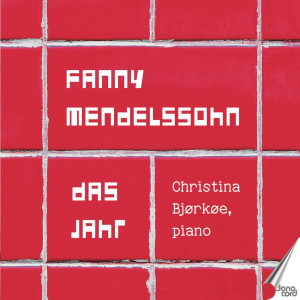
Fanny Mendelssohn (1805-1847)
Das Jahr: 12 Charakterstücke (1841)
Christina Bjørkøe (piano)
rec. 2021/22, Danish National Academy of Music, Odense, Denmark
DANACORD DACOCD957 [58]
Das Jahr was one of Fanny Mendelssohn-Hensel’s last major works. It was inspired by a year’s travel to Italy in 1839-1840 with her husband Wilhelm and their son Sebastian. After a brief visit to Leipzig to see Fanny’s brother Felix, the family arrived in Venice and then in Rome. In 1841, some months after her return to Berlin, she began composing Das Jahr. It is often interpreted as a diary of her travels but majoring on both the emotional and the topographical. She suggested that it “will form a delightful souvenir, a kind of second diary. But do not imagine that I give these names when playing them in society, they are for home use entirely.” This appears in Sebastian Hensel’s The Mendelssohn Family: From Letters and Journals (1882, p.103).
The booklet omits an important detail: the holograph was written on tinted sheets of paper, and Wilhelm illustrated every “month”. A short poem/epigraph heads up each piece. It is presumed that the score was a personal gift between husband and wife, not meant for publication.
The liner notes also do not say that Das Jahr is not just a collection of numbers but is a cycle in the same manner as Schumann’s Davidsbündlertänze. R Larry Todd in Fanny Hensel: The Other Mendelssohn (2010, p.254) points out that this is a highly structured work, with “related musical and extramusical elements and [with] an overarching key plan”. Critics who have studied Das Jahr have admired its cyclical structure and the various thematic cross-references. A good example of this connectedness is January – A Dream. There are intimations here of themes later to be heard in February, May, June, and August.
When one listens to the sequence of months – from January to December, plus a Postlude – it may be easy to imagine musical echoes of a Venice lagoon, the swirling snows of winter, Roman carnivals, or drifting waters by the riverbank in autumn. There is, however, a school of thought engendered by the German scholar Gottfried Eberle. It suggests that “correspondences between the music and Italian topics [are] difficult to substantiate and [that] Das Jahr could be enjoyed as absolute music without autobiographical encroachments.” (ibid., p.278). I indulged in a little bit of both approaches.
Fanny Mendelssohn introduced Lutheran chorales into the progress of the cycle. March includes a set of variations on Christ ist erstanden (Christ is Risen) for Easter. December opens with a depiction of a blustery snowstorm (possibly) but in the second half of the piece we hear Vom Himmel Hoch (From Heaven above) followed by two variations. The Postlude, Nachspiel, is based on Das alte Jahr vergangen ist (The old year is gone). Perhaps the use of these chorales reflects her brother Felix’s interest in Bach’s music and his revival of the St Matthew Passion in 1829.
It would be wrong to assume that Fanny Mendelssohn-Hensel’s piano music is, as one critic put it, Felix Mendelssohn-minus. The opposite is the case: it is Felix Mendelssohn-plus. Not only does the present work reveal her debt to Beethoven and Bach, but it looks towards the leaders of the Romantic generation of composers, including Robert Schumann, Chopin, Liszt and Thalberg.
The liner notes were a bit disappointing. After a short biographical note on the composer, the music is dealt with in only 200 words, and gives little background to Das Jahr or its interpretation. There are details about the pianist, Christina Bjørkøe, and a discography of her recordings.
The performance balances intimacy of mood with intensity in the more extrovert moments. Virtuosity stands alongside wistfulness, cheerfulness with meditation. As I noted, this is a cycle rather than a collection of discrete pieces. The overall impact of the performance is one of consistency, integrity and strength. It is enhanced by an excellent recording, typical of Danacord. I challenge anyone not to be moved by this powerful work of considerable creative strength and technical proficiency.
John France
Help us financially by purchasing through



















